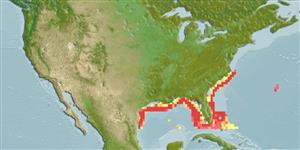Environment: milieu / climate zone / depth range / distribution range
Ecologia
marino demersale; distribuzione batimetrica 37 - 300 m (Ref. 5217), usually 73 - 180 m (Ref. 7251). Subtropical; 37°N - 24°N
Western Atlantic: North Carolina and northern Gulf of Mexico to southern Florida in USA; northern coast of South America (Ref. 5217).
Size / Peso / Age
Maturity: Lm ? range ? - ? cm
Max length : 17.5 cm TL maschio/sesso non determinato; (Ref. 7251)
Spine dorsali (totale) : 9 - 10; Raggi dorsali molli (totale) : 12 - 13; Spine anali: 0; Raggi anali molli: 11.
Inhabits offshore waters, mostly from 73-180 m depth. Minimum depth from Ref. 26912.
Life cycle and mating behavior
Maturities | Riproduzione | Spawnings | Egg(s) | Fecundities | Larve
Robins, C.R. and G.C. Ray, 1986. A field guide to Atlantic coast fishes of North America. Houghton Mifflin Company, Boston, U.S.A. 354 p. (Ref. 7251)
IUCN Red List Status (Ref. 130435)
Threat to humans
Harmless
Human uses
Strumenti
Special reports
Download XML
Fonti Internet
Estimates based on models
Preferred temperature (Ref.
123201): 17.8 - 23.9, mean 20.5 °C (based on 30 cells).
Phylogenetic diversity index (Ref.
82804): PD
50 = 0.5000 [Uniqueness, from 0.5 = low to 2.0 = high].
Bayesian length-weight: a=0.00525 (0.00220 - 0.01254), b=3.13 (2.92 - 3.34), in cm total length, based on LWR estimates for this (Sub)family-body shape (Ref.
93245).
Trophic level (Ref.
69278): 3.5 ±0.5 se; based on size and trophs of closest relatives
Resilienza (Ref.
120179): Alto, tempo minimo di raddoppiamento della popolazione meno di 15 mesi (Preliminary K or Fecundity.).
Fishing Vulnerability (Ref.
59153): Low vulnerability (10 of 100).
